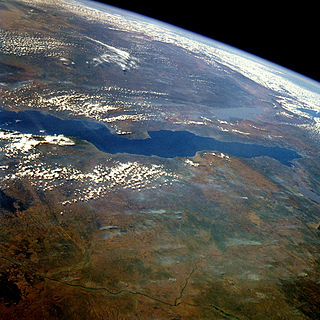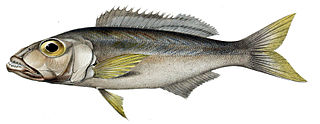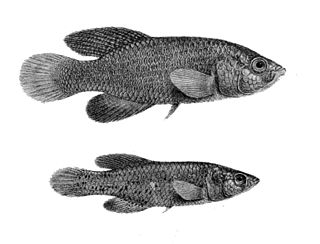
Lake Malawi, also known as Lake Nyasa in Tanzania and Lago Niassa in Mozambique, is an African Great Lake and the southernmost lake in the East African Rift system, located between Malawi, Mozambique and Tanzania.

Lake Tanganyika is an African Great Lake. It is the second-largest freshwater lake by volume and the second deepest, in both cases after Lake Baikal in Siberia. It is the world's longest freshwater lake. The lake is shared among four countries—Tanzania, the Democratic Republic of the Congo, Burundi, and Zambia—with Tanzania (46%) and the DRC (40%) possessing the majority of the lake. It drains via the Lukuga River into the Congo River system, which ultimately discharges at Banana, Democratic Republic of the Congo into the Atlantic Ocean.

The Tanganyika sardine is a term for two related species, both of which are small, planktivorous, pelagic, freshwater clupeid originating from Lake Tanganyika in Zambia. They form the major biomass of pelagic fish in Lake Tanganyika and Lake Malawi, swimming in large schools in the open lake, feeding on copepods and potentially jellyfish. Their major predators are four species of Lates which are also endemic to Lake Tanganyika, and are related to the Nile perch in Lake Victoria. All of these pelagic fish have suffered from overfishing in the last two decades.

Bathybates is a genus of piscivorous cichlids endemic to Lake Tanganyika in East Africa. The genus includes both pelagic species that mainly feed on Tanganyika sardines and benthic species that mainly feed on other cichlids. They are some of the deepest-living cichlids, regularly occurring down to 200 m (660 ft).

Rhamphochromis is a genus of East African haplochromine cichlids endemic to the Lake Malawi basin, also including Lake Malombe, Lake Chilingali, Chia Lagoon and upper Shire River. They mainly occur in offshore open waters, but a few species also near the coast. They are piscivores that typically feed on lake sardines and small utaka cichlids.

Enteromius litamba is a ray-finned fish species in the family Cyprinidae. It has long been placed in Barbus, the "wastebin genus" for barbs, by default, and this is still being done by the IUCN. However, the species is increasingly being restored by some taxonomists to the related yellowfish genus Labeobarbus, others place it in the genus Enteromius. It is presumably hexaploid like the other yellowfish.
Engraulicypris is a genus of freshwater ray-finned fish belonging to the family Danionidae, the danionins or danios. This genus is classified in the subfamily Chedrinae and the species in the genus are endemic to Africa. In a study of mitochondrial genealogy, the species formerly included in Mesobola are not phylogenetically separated from Engraulicypris and therefore should also be included in Engraulicypris.
The Malagarasi sardine is an East African species of freshwater fish in the family Danionidae. It is endemic to the Malagarasi River in Burundi and Tanzania. Its natural habitats are rivers, intermittent rivers, freshwater lakes, freshwater marshes, and inland deltas. It is threatened by habitat loss.
The lake salmon or mpasa is an African species of freshwater fish, endemic to Lake Malawi, in the family Cyprinidae found in Malawi, Mozambique, and Tanzania. Its natural habitats are rivers and freshwater lakes.
The dwarf sanjika is an African freshwater fish species in the family Cyprinidae. It is found in Malawi and Mozambique, living in Lake Malawi and the lower Zambezi River.
Dimidiochromis kiwinge is a species of haplochromine cichlid which is found in Lake Malawi and Lake Malombe in Malawi, Mozambique, and Tanzania. Its natural habitat is freshwater lakes.
Diplotaxodon ecclesi is a species of haplochromine cichlid. It is endemic to Lake Malawi, in East Africa, where it is found in open water at mainly at the deeper levels, although it is rarely caught by trawling. Its main prey is the Lake Malawi sardine.

The spotted killifish is a small, short lived species of fish, an African rivuline from the family Nothobranchiidae. These fish are native to many isolated freshwater pools located in the savannah depressions of east Africa, specifically Malawi, Mozambique, Zimbabwe, and South Africa. This species of fish occurs in ephemeral waters and killifish eggs can survive long periods of dehydration. The word killifish likely comes from the Dutch kil for kill.
Gilchristella aestuaria, the Gilchrist's round herring or estuarine round-herring, is a member of the family Ehiravidae that occurs off the coasts of Southern Africa. It is the only species in its genus, which was named for John Dow Fisher Gilchrist (1866–1926).

Usipa is a "small sardine-like fish that occurs in large shoals". Because of its small size, it is commonly dried. Usipa is mostly eaten in Malawi and Mozambique along with nsima ugali. Dried usipa is sold at most markets in Malawi. In Malawi, usipa is typically consumed with the bones in it due to their softness.
Engraulicypris bredoi is an East African species of freshwater ray-finned fish belonging to the family Danionidae. It is endemic to Lake Albert in Uganda and the Democratic Republic of the Congo. Its natural habitats are rivers, intermittent rivers, freshwater lakes, freshwater marshes, and inland deltas. It is threatened by habitat loss.
The river sardine, or hyphen barb, is an African species of [freshwater ray-finned fish belonging to the family Danionidae. It is found in the Cunene, Okavango, upper Zambezi river systems and east coastal rivers from the Limpopo to the Umfolozi in northern KwaZulu-Natal. It is also known from the middle Luapula in Zambia. Engraulicypris gariepinus is sometimes considered conspecific.
Engraulicypris gariepinus is an African species of [freshwater ray-finned fish belonging to the family Danionidae. It is found in the Orange River below the Augrabies Falls. It is sometimes considered conspecific with the river sardine.
Lake Malawi, also known as Lake Nyasa in Tanzania and Lago Niassa in Mozambique, is an African Great Lake and the southernmost lake in the East African Rift system, located between Malawi, Mozambique and Tanzania.
Engraulicypris ngalala is a species of freshwater ray-finned fish belonging to the family Danionidae, the danionins or danios. It inhabits the Rovuma River in Mozambique and Lake Chiuta in Malawi. It has a maximum length of 5.1 cm.









